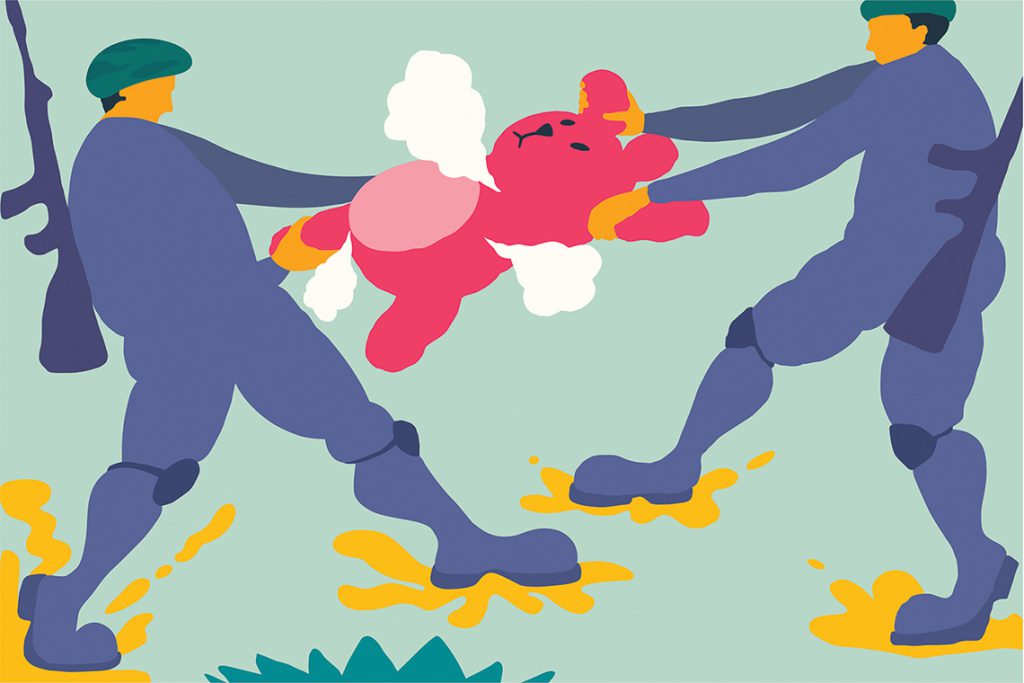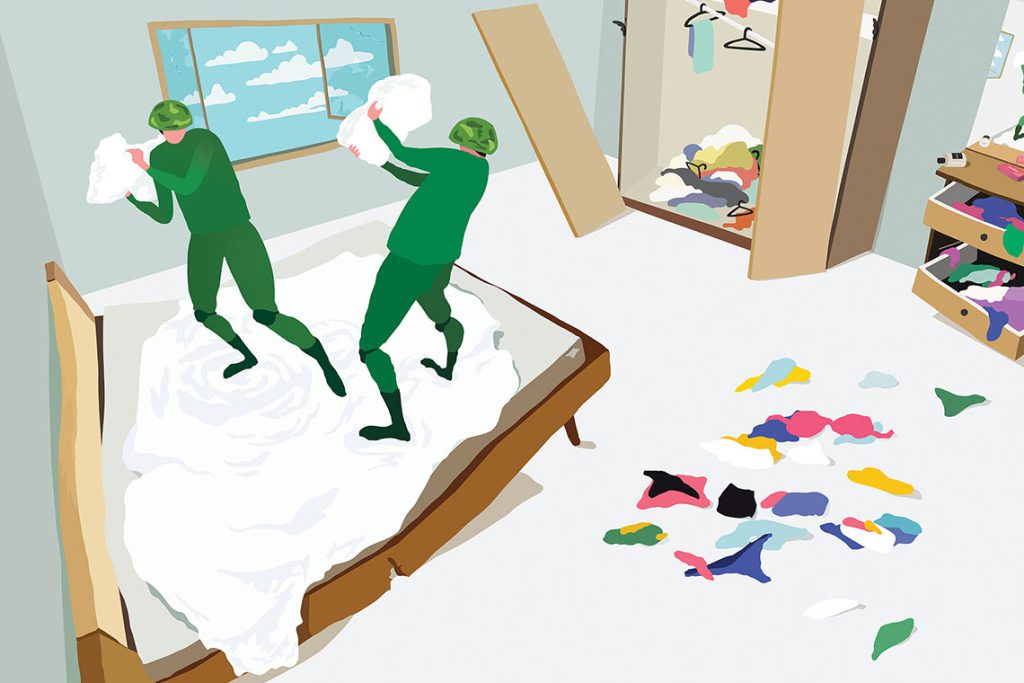The artist discusses how he uses dark humour and the contrasts between childhood and adult violence to reflect on the human condition.
Canvas: There’s often a sense of the absurd and humour in your pieces. How do these elements convey deeper meanings or messages about society and the human condition?
Saher Nassar: Humour is an essential part of my work. It is a tool shared between all people, something that everybody understands. It helps communicate ideas. Sometimes, when you want to talk about serious matters, people don’t want to listen, but when you talk about things in a more sarcastic way, people find it easy to engage with. It’s always been in my practice to use humour. Sometimes I try to find the balance where you can see the humour but it still hits you where it really matters. To me, this is the first stage in interacting with the viewer. Once they are inside what I’m visualising, then they start to understand what I’m talking about.
How does your work comment on the hidden aspects of society?
I always try to be a good social observer and I try to focus on the human element of my work. For my show at Zawyeh Gallery in Dubai, The Front Side Strikes The Most (2023), I tried not to be nationalistic, even though many of my works are about Palestine. However, the work is not exactly about Palestine, it’s about the human condition more generally.
For example, the soldier is a figure that we are faced with, and as a Palestinian, I was born facing soldiers all the time. They scared me, and it’s a fear that I have carried with me as I’ve grown up. I see the pictures on the TV and I see what they have done to other people. I also observe this subject on a larger scale, on a more humanistic level, which has pushed me to study the symbolism of the soldier from a historical, philosophical and social perspective.

The works in your recent presentation, entitled Residue and shown at this year’s Art Dubai, use a bright colour palette and juxtapose symbols of childhood with violence. How do you balance aesthetics and meaning?
I wanted to create something in contradiction with its subject. I had this matter before me that I wanted to confront, but it was so harsh. So I thought of portraying it in a cheerful way, which was especially important in the context of an art fair where you have people coming from all walks of life. They come and pass by, and you want something that will just hit them visually, pull them into your work and help them understand what you want to say. The same philosophy is used in The Front Side Strikes The Most exhibition, which is where the idea of creating works around soldiers started.
I wanted to understand what remained from one’s childhood within them that could manifest in these horrible actions. The question becomes one of asking: what has led to such a drastic shift in their mentality? How have they become these monsters, and why are they behaving in this way?
For instance, in Untitled No.3 (2023), I portray a female soldier. She is wearing a boot on one foot with a gun to her right and then on the other foot she is wearing a pink children’s shoe. Similarly, in Untitled No.1 (2023), two soldiers are fighting over a teddy bear. How silly could that be? In a way, it’s tearing apart the child-like innocence but also the fact that they are fighting over a toy shows you how stupid it is. Yet at the same time, this bear is probably something they took from a house that they invaded. You can see how the teddy bear is being torn apart, in a representation of the loss of childhood innocence.

What is the meaning behind the title of your series Children of the Occupation (2023)?
These children are the offspring of occupation, who have grown up with a destructive mentality and ruined morale. The scars left by the occupiers’ boots bore witness to the toll of conflict against innocent civilians, characterised as sadistic and reckless behaviour, or they are soldiers supported by a discriminating regime where words fail to encapsulate the magnitude of destruction, leaving the well-being and consideration of the home’s inhabitants entirely disregarded.
What is your approach to choosing the medium that effectively communicates your themes?
My representation is less about the medium and more about the idea. As a conceptual artist, the medium for me is a tool.
Could you elaborate on the symbolism behind the Network series (2021), particularly the use of actual blood samples?
The blood sample represents everything about your DNA. If I put your blood sample under a microscope, I will find out everything about you. I will know your age, if you are sick, if you’re a healthy person, if you have this or that virus, everything. I thought of it as I put them all in a box. The more information an authority has about you, the more they can control you, so I talk about how these bigger systems control everybody and I put the blood samples in a transparent box for the viewer to look at. Later on, I took each sample and explained it further by creating different shapes and colours that represent different personalities. Each one has a different abstract structure, and although they are similar in size and have the same colours, they all have a different formation.
Do you have any upcoming projects that you can reveal to us?
I am currently working on a collaboration between an institute in the UAE and Rhode Island School of Design. The project, called Decolonial Branding, will be shown simultaneously in both locations, but in two different languages. When I say language, I mean the behaviour and not only the language in a purely linguistic sense. It’s a united project with two different audiences, but connected through the same subject matter. I’m also going back a little bit in time to do some specialist work with mixed media. I am coming out of this period of not doing anything, so now I want to do everything. I have so much energy!
This interview first appeared in Canvas 114: Once Upon A Time



